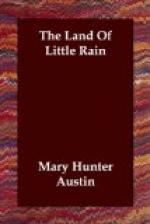They drift under the alternate flicker and gloom of the windy rooms of pines, in gray rock shelters, and by the ooze of blind springs, and their juxtapositions are the best imaginable. Lilies come up out of fern beds, columbine swings over meadowsweet, white rein-orchids quake in the leaning grass. Open swales, where in wet years may be running water, are plantations of false hellebore (Veratrum Californicum), tall, branched candelabra of greenish bloom above the sessile, sheathing, boat-shaped leaves, semi-translucent in the sun. A stately plant of the lily family, but why “false?” It is frankly offensive in its character, and its young juices deadly as any hellebore that ever grew.
Like most mountain herbs it has an uncanny haste to bloom. One hears by night, when all the wood is still, the crepitatious rustle of the unfolding leaves and the pushing flower-stalk within, that has open blossoms before it has fairly uncramped from the sheath. It commends itself by a certain exclusiveness of growth, taking enough room and never elbowing; for if the flora of the lake region has a fault it is that there is too much of it. We have more than three hundred species from Kearsarge Canon alone, and if that does not include them all it is because they were already collected otherwhere.
One expects to find lakes down to about nine thousand feet, leading into each other by comparatively open ripple slopes and white cascades. Below the lakes are filled basins that are still spongy swamps, or substantial meadows, as they get down and down.
Here begin the stream tangles. On the east slopes of the middle Sierras the pines, all but an occasional yellow variety, desert the stream borders about the level of the lowest lakes, and the birches and tree-willows begin. The firs hold on almost to the mesa levels,—there are no foothills on this eastern slope,—and whoever has firs misses nothing else. It goes without saying that a tree that can afford to take fifty years to its first fruiting will repay acquaintance. It keeps, too, all that half century, a virginal grace of outline, but having once flowered, begins quietly to put away the things of its youth. Year by year the lower rounds of boughs are shed, leaving no scar; year by year the star-branched minarets approach the sky. A fir-tree loves a water border, loves a long wind in a draughty canon, loves to spend itself secretly on the inner finishings of its burnished, shapely cones. Broken open in mid-season the petal-shaped scales show a crimson satin surface, perfect as a rose.
The birch—the brown-bark western birch characteristic of lower stream tangles—is a spoil sport. It grows thickly to choke the stream that feeds it; grudges it the sky and space for angler’s rod and fly. The willows do better; painted-cup, cypripedium, and the hollow stalks of span-broad white umbels, find a footing among their stems. But in general the steep plunges, the white swirls, green and tawny pools, the gliding hush of waters between the meadows and the mesas afford little fishing and few flowers.




